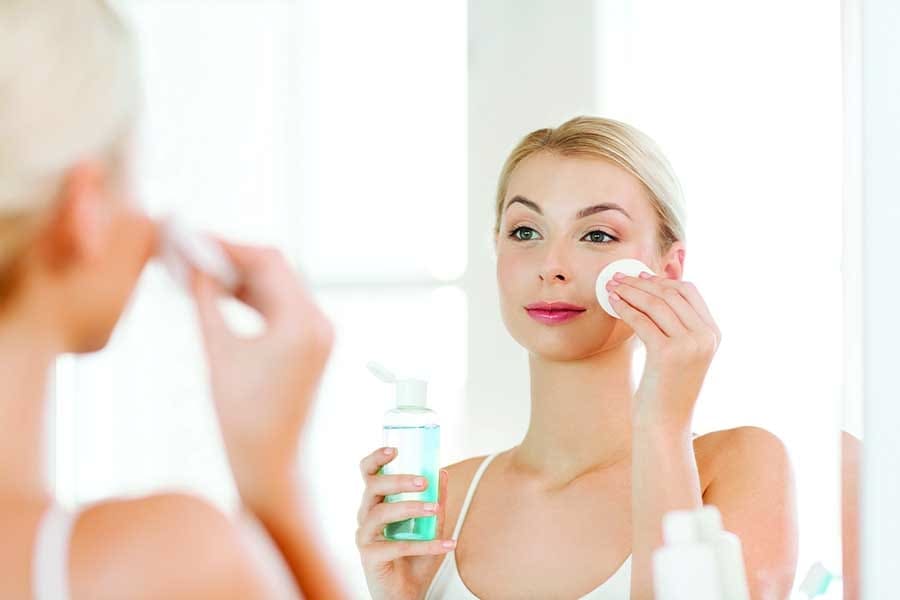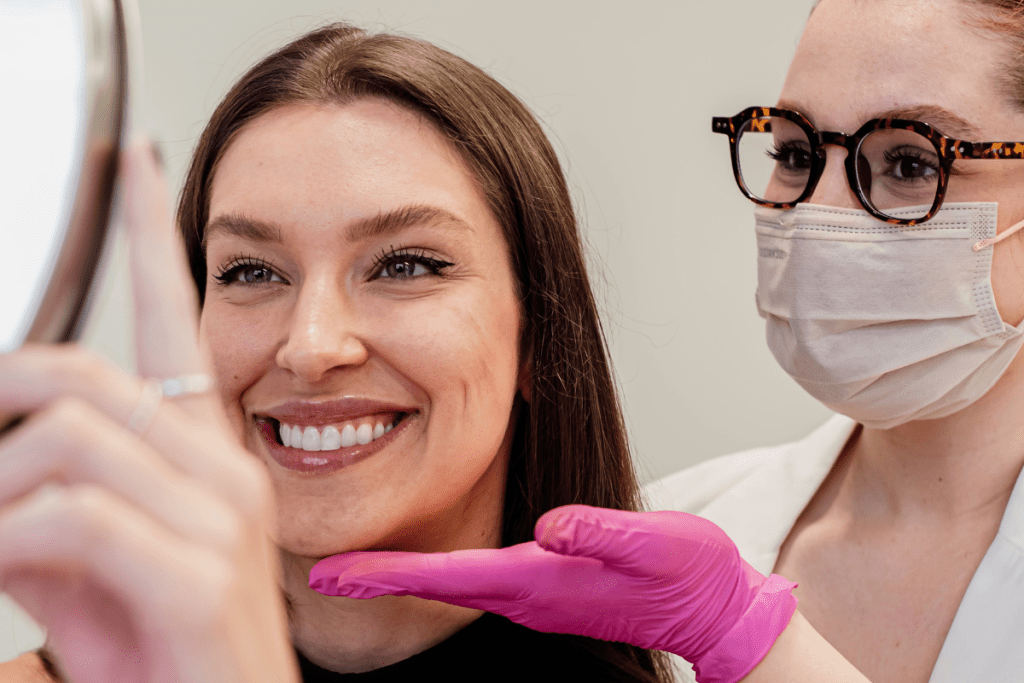
The difference between toners and astringents, and knowing which ones work best, can be confusing, as there are a myriad of products on the market listed as toners, astringents, mists, hydrosols, floral waters, and, more recently, micellar cleansing water.
The main difference between toners and astringents is the alcohol content. Toners and astringents can both be used to improve the surface of the skin through various ingredients. Toners typically help to remove traces of oil, perspiration, or makeup from the skin, while an astringent may be alcohol- or chemically-based and is used to deep clean the skin and close pores. Herbal toners are best for clients with normal-to-sensitive skin, while standard astringents work best on oily-to-combination or acne-prone skin.
Today, there are countless varieties of formulas available; so, professionals can customize their clients’ facial experience. Spend time researching herbal and plant ingredients to understand their efficacy and best uses for client skin types. Besides herbal varieties, today’s toners can also contain a myriad of vitamins, acids, and vegetable or fruit extracts. They can be applied in both spray form and topically. Depending on the formula and use, sprays can be convenient and easy for use on-the-go, while topical versions may be best applied during home care routines.
BENEFITS 
Many skin care products containing acids or SPF can disrupt normal pH balance. Using a toner after daily cleansing helps restore the disrupted acid mantel quickly. In addition, many skin toners help keep moisture locked in and can be used on-the-go when there is no time to wash the face. Spritzing the face on a hot summer day or a refreshing mist after a long plane ride or workout can be very satisfying. Facial toners and astringents also remove embedded oil and dirt, creating the appearance of smaller pores. Toners can reduce or remove harmful minerals and chlorine that may be present in tap water.
CONTRAINDICATIONS
Due to their typically gentle formulas, which are created to soothe and tone the skin, skin toners and astringents have few side effects. Excessive alcohol base may be the main culprit for irritation and allergic reactions. Ask clients if they have any issues with herbal- or plant-based ingredients. Choosing products that are sulfate-free and paraben-free also helps prevent the skin from breaking out or drying excessively.
BEST ACTIVE INGREDIENTS, TONERS, AND ASTRINGENTS
Many of today’s toner formulas do not contain alcohol and can be calming for irritated or sensitive skin. Clients suffering from rosacea or any dermal sensitivities would do best with non-alcohol-based, herbal toners containing soothing, anti-inflammatory ingredients such as chamomile, marshmallow, aloe vera, rose, comfrey, or calendula. Look for brands with as few ingredients as possible to keep allergic reactions or redness to a minimum.
Skin toners and astringents are also ideal for clients with acne-prone or oily skin. They can be based with isopropyl alcohol or include a reduced amount of alcohol or any other natural astringent, such as witch hazel or tea tree oil. Herbal blends best suited to acne contain willow, lavender, or citrus fruit extracts to reduce oil and tighten pores, as well as soothing herbs to reduce redness and inflammation.
Antioxidants aid cell regeneration and the repair of skin tissues. Vitamin E (tocopherol), lycopene (which is found in tomatoes), green tea, resveratrol (found in berries), grape seed, and niacinamide (vitamin B3) are all excellent ingredients to look for to boost antioxidant power. They can also hydrate the skin and improve overall texture.
Vitamins A, B, C, and E help to slow the aging process and are key components in cellular regeneration. Toners containing vitamin C and citrus extracts will also help brighten and lighten skin.
Trace amounts of essential oils may be added to the best skin toner products for fragrance purposes, while others are added for their therapeutic benefits. The most common essential oils include lavender, geranium, rose, and chamomile for their antimicrobial and inflammation-reducing properties. A lesser known essential oil, helychrysum, is a super skin healer for burns and scrapes.
MISTS
While toners are generally used as an evening skin care step to deep clean skin and prepare for additional moisturizers or serums, facial mists can be used throughout the day to help keep skin hydrated and refreshed. Some facial mists contain thermal or mineral water to deliver fortifying minerals that balance pH levels and protect the skin. Moisturizing or hydrating facial mists contain a water base and additional hydrating ingredients, such as essential oils, botanical extracts, or glycerin to help lock in moisture. Facial mists are good for all skin types and can be used to set makeup and give skin a dewy look. They are perfect on-the-go and ideal for keeping in a handbag or at work.
THERMAL WATER
Sourced from deep underground springs, thermal water is steeped in skin-fortifying trace elements and minerals, like calcium and selenium (an antioxidant), and is an excellent anti-inflammatory treatment for very sensitive skin.
Fruit-based face mists are more complex than simple infused water. For mature skin, moisturizing blends of coconut milk and coconut water help feed clients’ skin with potassium and vitamin C.
In hot weather, a moisturizing face spray with botanical extracts and essential oils can soothe and refresh heat-stressed skin of all types, including oily skin. Clients should use them liberally, as needed.
Do not let a mist or spray dry completely on the face if it does not contain a moisturizing ingredient. As water dries on the skin, it evaporates and draws out trace amounts of the skin’s existing moisture. Unless they are applying moisturizer immediately afterward, inform clients that they should spritz the face, wait a few seconds, then pat off the excess.
HYDROSOLS
Hydrosols are the condensate result of steam distillation of plants or flowers produced when creating a natural essential oil. The top floating layer of essential oil is removed and the remaining 90 percent of the water is considered hydrosol.
The terms floral water, herbal water, toilet water, and aqua vitae are commonly interchanged with hydrosol, but beware: the two products can differ vastly depending on the manufacturer. A pure hydrosol is solely plant-based and food grade, meaning it is edible. Typical floral waters found in supermarkets, drug stores, or ethnic food shops may contain non-organic ingredients such as alcohol, chemically produced fragrance, or man-made food dyes. Most often they are infused with essential oils, and cannot be considered a true hydrosol. Pure hydrosols contain some of the same aromatic molecules as essential oils, but in a much lower concentration. They are typically clear and colorless and have a light, trace aroma of the original plant or flower.
Additionally, being organic, a true hydrosol does not have the extended shelf life of a formulated floral water and can turn rancid or lose its scent with time. It is always best practice to refrigerate any pure, natural skin care products and check frequently for color and scent changes.
MICELLAR CLEANSING WATER
The latest skin care trend is micellar cleansing water. A large number of skin care manufacturers have recently added this new product to their repertoire. Unlike toners or astringents, this cleansing water is made up of micelles – tiny balls of cleansing oil molecules – suspended in soft water. The concept is that micelles are attracted to dirt and oil, so they are able to draw out impurities without drying out the skin. Thus, micellar cleansing water is marketed as a face cleanser and makeup remover but is not a toner or astringent.
There are many products available on the market when it comes to moisturizing and cleansing. Professionals can better come to understand the difference between toners, mists, astringents, and hydrosols by learning about the benefits, contraindications, and ingredients of each. This knowledge will then empower professionals to make the best choices when it comes to stocking their spas and recommending products to clients.
Rachelle Dupree has over 20 years of experience in marketing, media, and communications. She earned a bachelor’s degree in communication arts and marketing and a second degree in graphic design. She studied with a Denver-based herbalist and naturopath for four years, combining her marketing knowledge with her love of natural remedies. She currently contracts as a marketing and communications director for Vivoderm Natural Skincare and various design clients.
{gallery}resources/2018/Name-Game::::2{/gallery}





















0 Comments